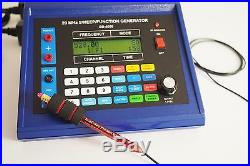

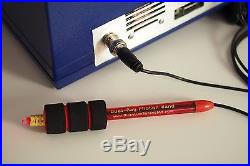
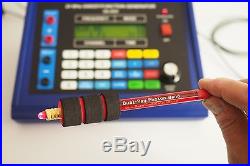
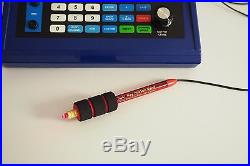
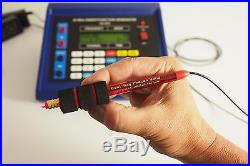

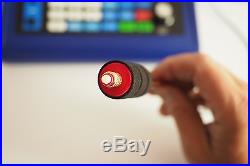

Exclusive – New for 2017 Latest LED Technology for the GB-4000! Dual-Ray LED Photon Wand (GB-4000 Not Included). Turn your GB-4000 frequency generator into an advanced, pulsed, high power, LED photon light therapy machine. New “DUAL” 660 nm (visible red) and 850 nm (infrared) LEDs for greater power and penetration. This is a true breakthrough for GB-4000 owners and users. Our new 2017 GB-4000 Dual-Ray Photon Wand contains TWO LEDS in a unique “stacked” array. Never before has this breakthrough technology been available for an RF Frequency Generator such as the GB-4000. The GB-4000 Dual-Ray Photon Wand plugs directly into the BNC Output Jack on the rear of the GB-4000 and is designed exclusively for this instrument. Simply plug the GB-4000 Dual-Ray Photon Wand into the BNC output jack on the rear of the GB-4000. Make sure that the GB-4000 is in RF Mode. Select your frequency, adjust the intensity, and run. Watch as the frequencies are pulsed through the new 660 nm (visible red) and 850 nm (infrared) DUAL LEDS. THE SCIENCE BEHIND IT – WAVELENGTH OF CELL TISSUE. About eighteen years ago, researchers at the University of Chicago discovered that the average wavelength of cell tissue in the human body ranged between 600 nm and 720 nm. We believe that 660 nm visible red and 850 nm infrared seem to create a strong sympathetic vibratory resonance in the human body cell range discovered by research at the University of Chicago and works very well because it is in the range of the resonant frequency of cell tissue and seems to absorb better in hemoglobin. INCREASED HEALING IN THE 660 nm and 850 Infrared nm wavelengths. As you move toward the red end of the color spectrum, the rate of cellular regeneration increases. For instance, a single frequency in the green range of the color spectrum might affect the kidneys 40 times better than a normal base-line study, whereas a red range would be about 4,000 times faster. Over the years, researchers migrated to infrared, red and eventually the 660 nm wavelength because it was found to be the fastest way to regenerate tissue. So if you have an injury you would normally recover from in ten days, you may actually recover that tissue in two days by application of 660 nm red light. Now, it has been discovered that by combining the visible 660 nm red light with infrared (IR) 850 nm light wavelengths, the process becomes exponentially more effective. Researchers also found that irradiating mitochondria with red and infrared light causes them to produce cytochromes, which increase their efficiency. LED light has been shown by NASA. To dramatically decrease wound healing time. This is supported by several clinical trials. It is not known why this works yet, but the hypothesis is that light may supply extra energy to cellular organelles. Here are some of the benefits of LED based therapy according to the research links listed below. Apply to wounds, cuts and burns to accelerate healing. May give instant relief for insect bites and stings to prevent swelling. May accelerate the healing process and regenerates tissue. May stimulate production of collagen to rejuvenate skin. Increases fibroblast cell proliferation to stimulate repair processes. Helpful healing aid for people whose immune systems are weakened. Often used for ulcers and bedsores. Imprint GB-4000 frequencies into water, homeopathics, vitamins, minerals, supplements, almost anything! Our exclusive design, only available here! GB-4000 Frequency Generator Not Included. Therapeutic Effects of Monochromatic Red Light. This instruction is brought to you by the Aesklepeon of Light, a non-profit organization in Seattle. We will be discussing the use of a very particular type of light to help alleviate physical problems in your body, reduce emotional stress and eliminate allergy reaction. Right at the beginning we want to emphasize that we are not licensed medical doctors. We are neither diagnosing nor prescribing. We are not licensed in any medical field and we encourage You to seek or continue using licensed medical help with your problems. As a licensed non-profit organization in the State of Washington we will be discussing the use of light as a supplement to your normal medical treatment. The techniques and results described in this publication represent observations and personal use by thousands of individuals since 1969 when the first patents were established in the United States. We do not recommend any specific company or product and prefer to provide enough information to allow the individuals to decide that issue for themselves. THE NATURE OF LIGHT (1) What type of light is being used? (2) Why does it work? (3) What functions of a light unit are important? We all know that light, sunlight, is essential for all living things. Over the years the use of artificial colored light as a therapeutic aid has proved successful, but not consistent. We feel the reason for this, is that the colored lights which were used actually consisted of many frequencies. An example is a white incandescent bulb using a red coating or filter over it. When this light is analyzed scientifically, it actually shows many frequencies of red plus traces of blue, yellow, orange and green as well. Current research has shown that the most effective results, of using light on the body, are obtained when using a single frequency or wavelength of light. This is referred to a monochromatic light. To help you understand what we mean when we talk about wavelengths, please refer to your appendix, page AI where the electromagnetic spectrum is displayed. Sunlight is part of this spectrum. Sunlight itself consists not only of the visible light but ultra-violet and infra-red. In addition, each of these visible colors is not just a single wavelength, but is comprised of a range of wavelengths so that you actually have a band c. This can be seen more clearly in page A2. Take a look at the green. It ranges from 490 nanometers to 560 nanometers. What that actually means is that the green light consists of 70 different wavelengths. This chart is a good reference tool. It shows you which frequency ranges constitute each of the main color bands. In addition, you can look at each color band and see the relative penetration power into human tissue. We also have included the infra-red and the ultra-violet frequencies. Now, getting back to the research results. Red wavelengths of 630, 660 and 670 nanometers have been commonly used. Good results also have been obtained using infra-red wavelengths at 880, 940 and 950 nanometers. Our preference is the 660 red frequency because of it’s visibility and it’s compatibility with the cells of the body. In addition, our desired light needs to be focused into a narrow beam, not scattered. The light also should be bright enough to penetrate deeply into the tissue. The brighter the light, the more biologically effective it will be. The brightness should be at least 4,000 millicandles and it could be as high as 6,000 millicandles. So, essentially, the light should be a bright, monochromatic red color and focused into a narrow beam. Monochromatic means that it should contain no other color wavelength except 660 nanometers. There are two methods to accomplish this. One, use a low powered, 2 milliwatt laser, or two, a light-emitting-diode (LED) with power up to 50 milliwatts. We prefer the LED because it is less and it is less technical to use. It’s also smaller, lasts longer, and is non-dangerous to the eye or any other part of the body. The LED uses non-coherent light rather than the laser’s coherent light, so there is no way that tissue can be damaged. Non-coherent literally means that the light is broken up or caused to be out of phase. Coherent laser light is specifically phased to increase it’s strength and focusing power. The Food and Drug Administration, though, has approved the use of low wattage lasers as long as a physician warns the patient as to the experimental nature of the device. Based upon research and observed results, we feel the use of the LED light is equal to the low power laser and in many applications it is superior (sometimes an LED can be used when lasers may not). While the more expensive machines usually have more functions, these functions aren’t always necessary to the average user. The functions include plug-in light probes, with different LED colors. There are also adjustable brightness, adjustable pulse rates, electro-acupuncture probes and acupressure paint readout meters. In addition, some are plugged into 120-volt power out-lets while others Use throw-away or rechargeable batteries. But when it comes down to applying the red light for a specific purpose, when you know exactly what you want to accomplish, then all the machines are essentially the same. So our advice to the average person is obtain an inexpensive light unit first, then later acquire a machine with more functions, if that interests you. Practitioners can make better use of the expensive units. Practitioners are acupuncturists, chiropractors, naturopaths and doctors and dentists. We also want our light unit to be able to select both a continuous or a pulse beam. A preferable pulse rate is 250 cycles per second since this is most compatible with the body’s nervous system. You will not be able to see this pulse rate since your eye can only see about 45 cycles per second; but, if you move the light rapidly from side to side, you can distinguish the pulses which appear as a broken light image. So, the essential basic light unit should contain a 660 nanometer red LED of 4,000 – 6,000 millicandles with both a continuous and a 250 pulse-per-second light beam selector. This will accomplish about 80% of the application requirements. If you want to upgrade further, the next options should be an alternate 830 nanometer or 940 nanometer infra-red LED probe, a brightness adjustment and a pulse selector switch ranging from 10 pulses-per-second to a high of 5,000. Battery operation, normally 9-volts, is adequate. BY the way, with most battery units, you can tell when the battery is getting low by switching between continuous and pulse settings. If, the LED turns dim, replace the battery. Otherwise, if the brightness is the same on both settings the battery is still strong. Battery tasters are desirable. PRIMARY USES AND TECHNIQUES – PAIN RELIEF AND HEALING. Now that we have discussed the nature of the light we are using, it is time to talk about its main uses. The first feature is its ability to reduce or eliminate pain and swelling in the body. The second feature is its ability to increase the rate of healing of diseased or damaged tissue. The first uses the continuous beam, while the second utilizes the pulse beam. The light itself is not doing the healing. Rather, it is providing the necessary energy to the cells, specifically to the DNA molecules in the cells, and the cells perform their own healing. To help visualize this process under normal conditions, picture natural sunlight entering the body and providing energy to every cell in the body. This energy must pass through pathways in order to complete the distribution of energy to the DNA molecule in each cell. These pathways are referred to as the acupuncture, acupressure or the meridian system. The DNA in turn directs the energy to the cell membrane. When the energy is cutoff or overloaded to an area of the body, the cells in that area cease to function normally. The cutoff or overload of energy may be caused by injury, disease, infection, tension, stress, tear, guilt or any number of sources. One way of helping to this adverse condition is to use the light to provide an energy-transfusion to the distressed cell. The light can be applied by two methods. Either directly to the problem area or indirectly via those acupressure points that are connected with the problem area. The light’s wave length, 660 nanometer red, plus it’s brightness allows it to penetrate quite deeply into the body’s tissue. In addition, the light rays bounce off the water contained in the body tissue. This scatters the rays even deeper, and affects the surrounding cells. You can reach virtually any spot within the body directly with the light. It is always better to apply the light in a darkened area. For direct application, hold the light probe close to or on the skin, directly over the area you wish to work on. Rotate the light slowly clockwise, that is, towards the right. Remember, don’t use the light through clothes, remove your clothing first. Apply the light for 5-20 minutes, depending on the severity of the problem. Then, wait for 40 minutes. If the pain still persists, proceed with another treatment. Repeat this process as often as necessary until the pain is gone. Remember to use the continuous light beam setting for pain and swelling, and use the pulse beam for the healing of diseased or damaged tissue. The continuous beam is sometimes referred to as the solid beam. Again, to help Visualize what is taking place, picture the beam of light energy penetrating down to the problem cells. When there is Pain, the cell walls can be pictured in a state of extreme tension. The continuous beam provides a vibrational signal to the DNA in the cell. The DNA, in turn, instructs the walls or membranes of the cell to relax. As the cells relax, the tissue made up of those cells also relaxes. This is followed by the relaxing of the muscles and the pain subsides. In addition, the light increases the blood circulation in the area that it penetrates. This increased circulation results in a warm, glowing feeling within the problem area which further adds to the soothing effect on the painful area. When there is disease or damage, the cell walls can be pictured as shrunken, deformed and transparent or fading. The pulse light beam provides a stimulating, rejuvenating energy to the DNA in the cell. The DNA transmits this energy, via a protein or calcium transfer, to the cell walls and the cells transform to healthy looking solid shapes as the treatment progresses. The energy supply which had been blocked from these cells has been replaced with the energy of the light unit and the DNA molecule now has the energy to do its normal function. There seems to be several reasons why this particular light is so effective. The wave length emitted by healthy cells averages between 600 and 725 nanometers, whereas unhealthy cells emit a shorter wavelength. The 660 nanometer red is in the middle of the healthy call wavelength range and therefore appears to be in close harmony with the cell. This could explain why infra-red frequencies (remember the 880 and the 940 frequencies) which, although they penetrate deeper into the tissue, still have slower healing times than the red light. In addition, the DNA in the cell appears to respond much more quickly to a single frequency of light than to natural sunlight, which contains all the color frequencies. It seems that the DNA, when it is deprived or overloaded with energy would prefer to communicate or respond to only one frequency at a time, much like your wanting to talk to one person at a time rather than simultaneously with many people. The following physical problems have been either observed, reported or researched as having shown significant pain reduction when the light is applied. Headaches, ear and toothaches, tense muscles, pulled muscles, sprains, cuts, burns, back pain and arthritis pain. Likewise, faster healing rates have been noted in physical problems like wounds, burns, psoriasis, rashes, tendonitis, herpes, torn ligaments, arthritis, circulatory conditions, organ and tissue degeneration and sinus. You can feel tree to experiment with other conditions. The use of the red light has produced no known side effects. It does not cause any tissue damage and it cannot be over applied. At times, a temporary increase in discomfort occurs with chronic. This has been noted AS an indicator of tissue reactivation, or detoxification, and precedes improvement. We recommend that under no circumstances should you use this treatment in place of your normal medical treatment simply use it as a supplement. In 1965, when monochromatic light was first developed, the only way to produce it was with a low power or soft laser. As a result, the majority of the research since that time has dealt with the use of soft lasers. A low-power laser differs from normal high-energy lasers in that the amount of light and energy generated is very weak. Soft lasers create an almost homeopathic stimulation of the cells whereas high energy lasers can destroy the cells (such as in laser surgery). Recently Liqht-Emitting-Diodes (LED) have undergone dramatic changes. As technology has improved, LED’s have changed from being just simple “indicator type lights” in electronic equipment (20 millicandle power) to today’s ultrabright and unique wave length LED (6, 000 millicandles). This has provided a sate, less costly and available alternative to the low power soft laser. An LED generally produces about 85% of the results of a soft-laser e. Pain relief in 7 minutes instead of 6 minutes. Today more and more research, using LED’s instead of soft lasers, is being published. The majority of soft laser research is directly applicable to the use of LED. Remember to apply the light in a darker environment for maximum effect. The thirteenth feature deals with skin conditions – some of the early research, using soft laser units, showed dramatic results with wound-healing, ulcers and skin conditions. The types of skin condition include Eczema, Psoriasis, Acne, Tinea, Herpes, some nervous rashes and scars. Scar tissue improvement is more rapid with new scars than with older ones (those over two years old). The LED light units have shown comparable results to the soft lasers. In most skin problems pain is not present. But if there is still some itching or irritability, use the solid (continuous) beam initially until this condition has been reduced or eliminated. Many of the skin conditions may have no irritating feeling at all (just the visual effects of the skin problem itself). Therefore, you can immediately use the pulse light setting to accelerate the cell regeneration. Again, hold the light close to the skin and rotate slowly clockwise over the affected area for 5-10 minutes (3-4 times per day). It has been noted that in some cases, working with the light over one affected area has resulted in improvement in other non-connected affected areas. For some types of recurring skin condition, such as it is important to apply the light when the first stages of the problem begin to manifest e. Itching, redness, heat and swelling. It has been observed that by applying the light early in the cycle of the problem, it will generally stop the balance of the reaction. If the reaction is already well underway, then the light will accelerate the healing cycle (observed to heal approximately 3 to 5 times faster than without the light). If the light is applied early during the wound healing process, the rapid acceleration of cell regeneration will usually result in no scabs and no scars. Again, as always, the light treatment is to supplement whatever existing treatment you are already taking under the direction of your physician. TEETH AND GUMS (PERIODONTAL). The fourteenth feature relates to another highly researched application of the soft laser, namely the dental area. The light is used to reduce both toothache pain and post-dental treatment pain. The LED light again is comparable to the soft laser results. Use the solid (continuous) light setting for pain relief. Since the light easily penetrates through the thin skin of the cheeks, it is not necessary to apply the light through the open mouth, unless you desire to do so. Treatment time is 7 to 12 minutes repeated each hour until the pain is sufficiently reduced. The excellent results in improving Gum or Periodontal problems is especially notable. In these cases, the pulsed light setting is used and is also generally applied through the thin tissue of the cheek. Shorter treatments (5-7 minutes) applied frequently throughout each day (4-5 times) is the most effective. Give the gum problems 7-10 days to start showing improved results. You now know what Light-Emitting-Diode (LED) monochromatic red light is, it’s main uses, why it works and the techniques of direct application to the body and indirect application through acupressure and meridian points. So, now put it to use on a regular basis. The light, in some cases, is working with the symptoms of the problems, not the source. But, we feel that if you can alleviate the discomfort of the symptoms, you will be in a better position to deal with the source. The real source of the problem is very often lodged in our subconscious. Many fears, guilts, emotions and negative programs hold sway over our physical bodies. We feel that the light is a tool and a step towards understanding and better health. Our lives on this planet are based on light and sunlight. We must have its energy flowing freely through out bodies. Using one slice of that light, namely the red 660 nanometer frequency, is a natural way to help heal any flaws in that energy flow without leaving any negative, long-term effects on our bodies. The item “Dual-Ray LED Photon Wand for the GB-4000 Frequency Generator NEW for 2017″ is in sale since Friday, July 01, 2016. This item is in the category “Health & Beauty\Natural & Alternative Remedies\Electrotherapy Devices”. The seller is “quantumbalancing” and is located in Cascade, Colorado. This item can be shipped worldwide.
- Brand: QuantumBalancing.com
- Model: Dual-Ray LED Photon Therapy Wand
- MPN: DRPW1
- Country/Region of Manufacture: United States